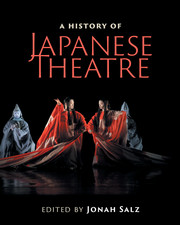Book contents
- Frontmatter
- Contents
- List of figures
- List of tables
- Contributors
- Contributors’ biographies
- Foreword
- Acknowledgments
- Note on Japanese terms
- List of abbreviations
- Timeline
- Editor's introduction
- I Traditional theatres
- Preface to Part I Japanese civilization arises
- II Modern theatres
- Preface to Part II
- 6 Birth of modern theatre: shimpa and shingeki
- Interlude Modern comedies and early musicals
- Interlude Takarazuka: all-girls’ revue and musicals
- 7 Rise of shingeki: Western-style theatre
- Interlude Manzai and Yoshimoto vaudeville comedy
- 8 Wartime colonial and traditional theatre
- Interlude Kami-shibai: picture-card storytelling
- 9 Maturing shingeki theatre
- Interlude Postwar musicals and commercial theatre
- 10 Sixties Theatre
- Interlude Butoh: dance of darkness and light
- 11 Contemporary theatre
- Interlude Tokyo: world theatre capital
- Interlude Charting Tokyo theatre today: 24 November 2012
- Interlude Modern theatre tomorrow: interview with Oriza Hirata
- III Arcs and patterns
- IV Theatre architecture
- Preface to Part IV Evolution of Japanese theatre architecture
- V Theatre criticism
- VI Intercultural influences
- Epilogue: Frozen words and mythology
- Further reading
- Index
- References
Interlude Takarazuka: all-girls’ revue and musicals
from Preface to Part II
Published online by Cambridge University Press: 05 July 2016
- Frontmatter
- Contents
- List of figures
- List of tables
- Contributors
- Contributors’ biographies
- Foreword
- Acknowledgments
- Note on Japanese terms
- List of abbreviations
- Timeline
- Editor's introduction
- I Traditional theatres
- Preface to Part I Japanese civilization arises
- II Modern theatres
- Preface to Part II
- 6 Birth of modern theatre: shimpa and shingeki
- Interlude Modern comedies and early musicals
- Interlude Takarazuka: all-girls’ revue and musicals
- 7 Rise of shingeki: Western-style theatre
- Interlude Manzai and Yoshimoto vaudeville comedy
- 8 Wartime colonial and traditional theatre
- Interlude Kami-shibai: picture-card storytelling
- 9 Maturing shingeki theatre
- Interlude Postwar musicals and commercial theatre
- 10 Sixties Theatre
- Interlude Butoh: dance of darkness and light
- 11 Contemporary theatre
- Interlude Tokyo: world theatre capital
- Interlude Charting Tokyo theatre today: 24 November 2012
- Interlude Modern theatre tomorrow: interview with Oriza Hirata
- III Arcs and patterns
- IV Theatre architecture
- Preface to Part IV Evolution of Japanese theatre architecture
- V Theatre criticism
- VI Intercultural influences
- Epilogue: Frozen words and mythology
- Further reading
- Index
- References
Summary
The Takarazuka Revue Company is an all-female theatre that began as the Takarazuka Shōjo Kageki (Takarazuka Girls’ Opera) in 1914 at a spa town near Kobe in western Japan. A cultural venture of Kobayashi Ichizō (1873–1957), the Hankyū Railroad industrialist, the town was planned as a leisure destination for affordable family entertainment; it also featured a botanical garden, zoo, and amusement park. The Takarazuka Gekijō (Takarazuka Theatre) grew into its most popular feature, the only attraction remaining today.
Takarazuka's first performance was Don-Burako, based on the folktale Momotarō (Peach boy), staged in modified kabuki style, one of the first successful operettas employing Western music sung in Japanese. Kobayashi's goals were to establish a modern Japanese musical theatre as well as to change conventional assumptions that the only professional female performers were geisha.
Student professionals
The Takarazuka Music School was established in 1919, with artistic and moral instruction based on Kobayashi's maxim, “Purity, Honesty, Beauty” (Kiyoku, Tadashiku, Utsukushiku). Takarazuka recruited educated, middle-class girls, and trained them as respectable “students” (seito). Today, only girls, from 15 to 18 are allowed to audition for the school; successful candidates must remain unmarried. The school provides two years of training in Western and Japanese performing arts – singing, dancing, and acting. All Takarazuka performers are graduates, performing as “students” and maintaining a strict senior–junior hierarchy throughout their careers.
Each troupe features a top star, usually a male-role performer (otokoyaku) paired with a female lead (musumeyaku). Takarazuka has in-house playwright-directors, composers, and orchestras that include both men and women. The company consists of five troupes of about eighty professional performers each: Flower (1921–), Moon (1921–), Snow (1924–), Star (1933–), and Cosmos (1998–).
Foreign adaptations
Takarazuka has been responsible for introducing many forms of foreign culture to the Japanese public. The 1924 Daigekijō (Grand Theatre, 3,500 seats) featured advanced stage technology (see p. 428). The first Japanese revue, Mon Pari (My Paris, 1927), was followed by the more spectacular Parizetto (Parisette, 1930), which established the Takarazuka revue style. The company produced original scenarios as well as adaptations of foreign works, creating multicultural hybrid spectacles. Music and choreography, derived from flamboyant European revues and American shows, included fast tempos and geometrical choreographic formations. Popular French chansons were indigenized, as were jazz sections and visual extravaganzas in the manner of the Ziegfeld Follies.
- Type
- Chapter
- Information
- A History of Japanese Theatre , pp. 230 - 233Publisher: Cambridge University PressPrint publication year: 2016

